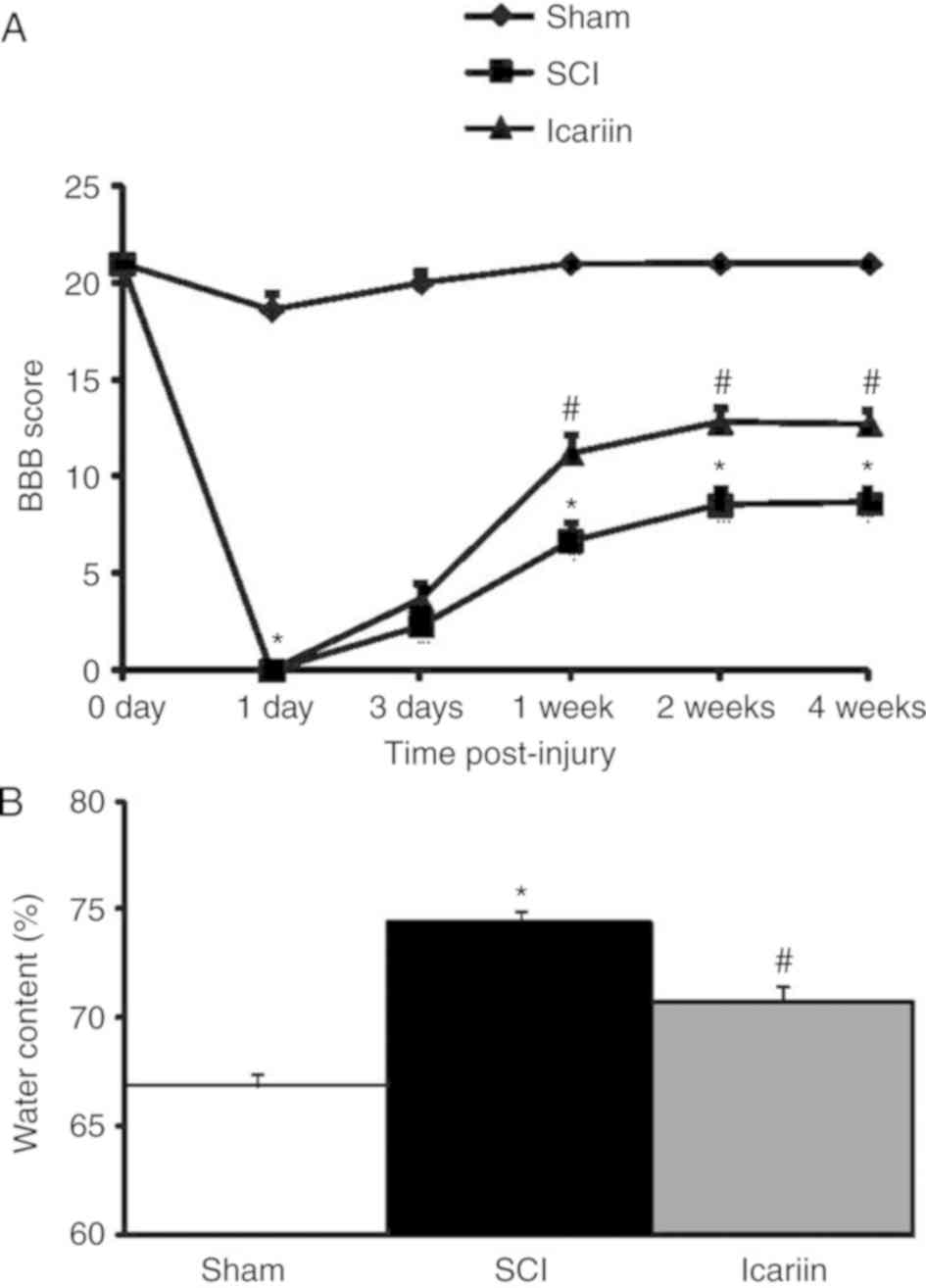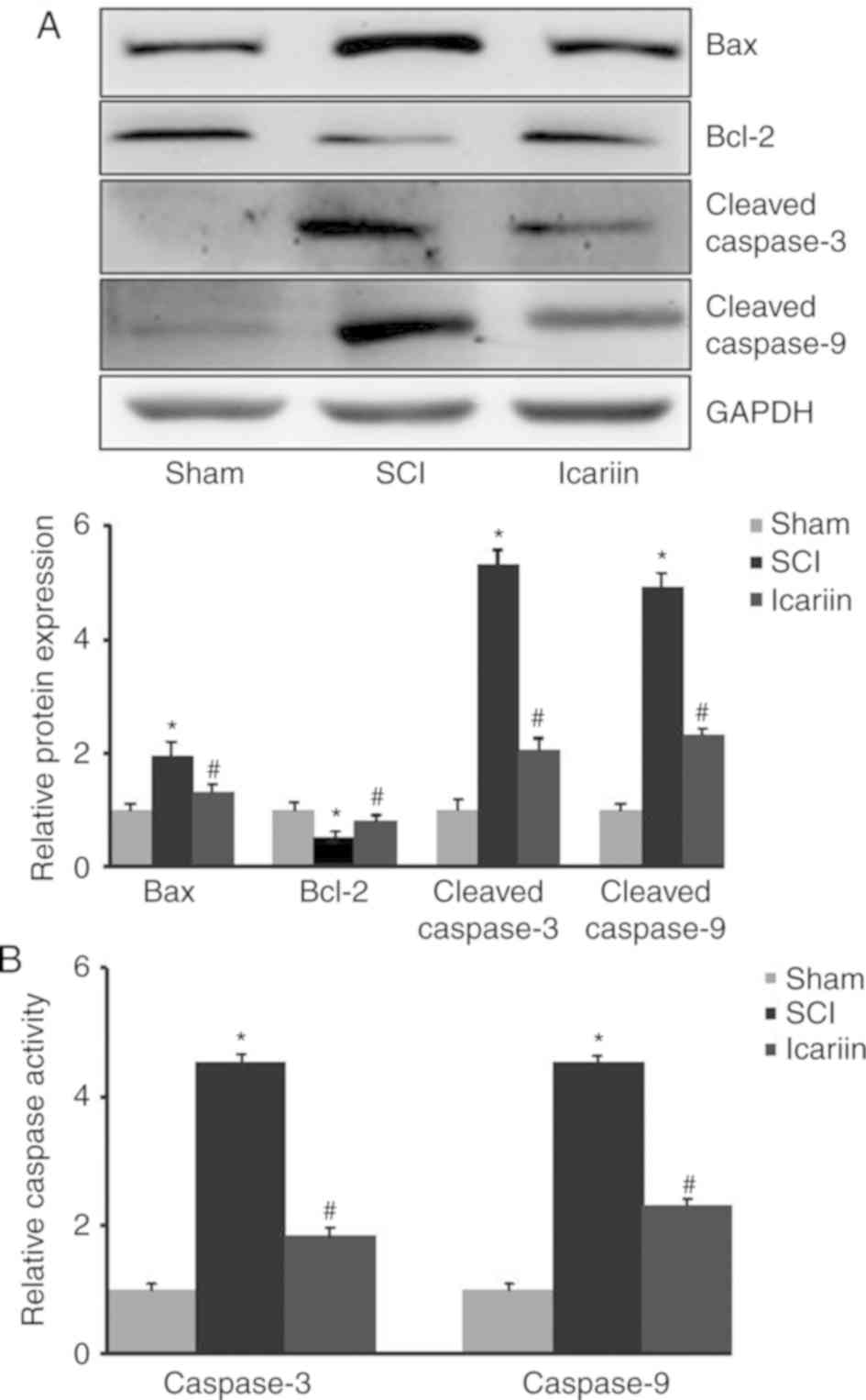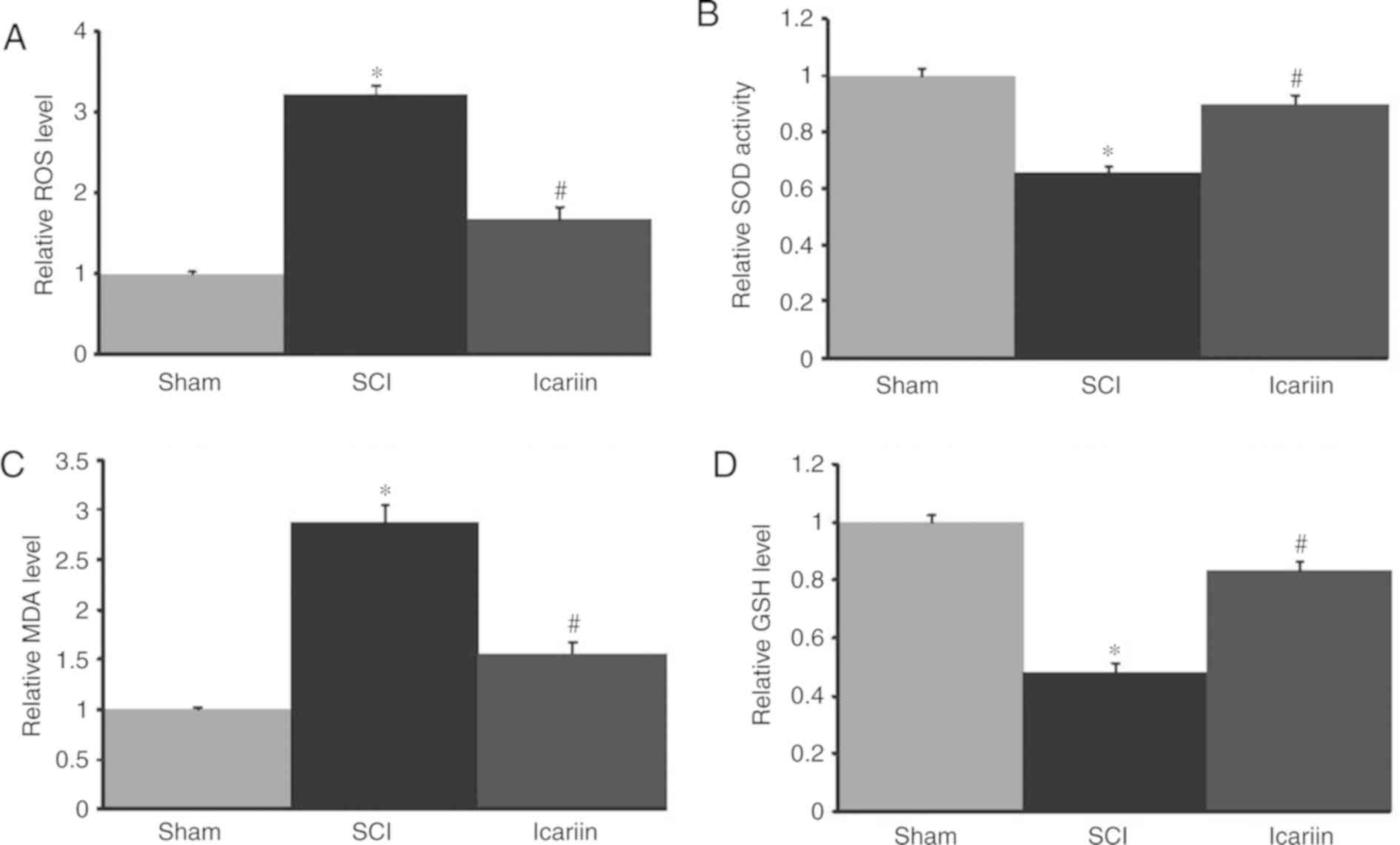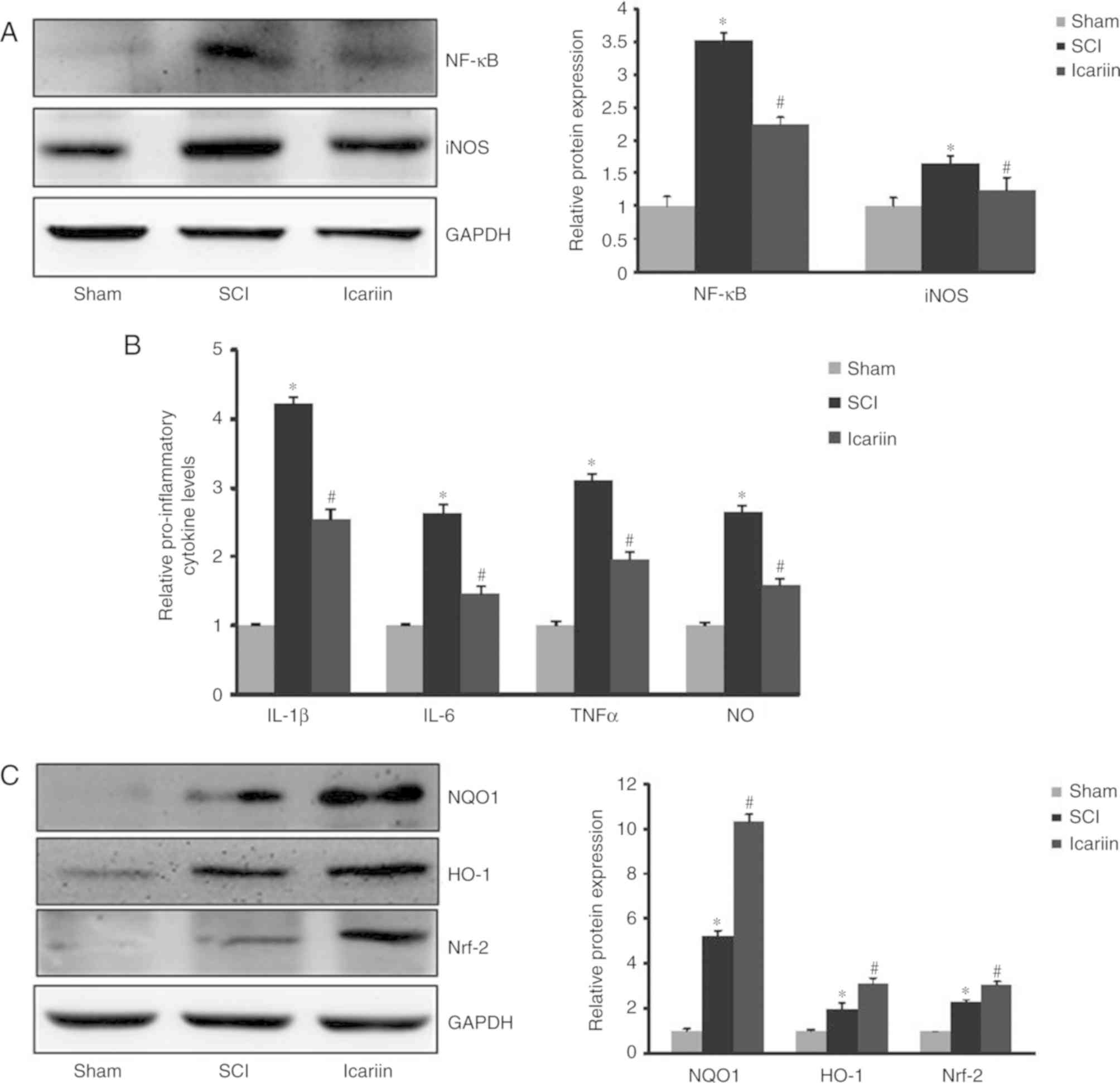|
1
|
Xu M, Li H, Zhao Z, Yang Y, Sun Z, Han H,
Zhang X and Reinhardt JD: Environmental barriers, functioning and
quality of life in 2008 Wenchuan earthquake victims with spinal
cord injury eight years after the disaster: A cross-sectional
study. J Rehabil Med. 50:866–871. 2018. View Article : Google Scholar : PubMed/NCBI
|
|
2
|
Maitan P, Frigerio S, Conti A, Clari M,
Vellone E and Alvaro R: The effect of the burden of caregiving for
people with spinal cord injury (SCI): A cross-sectional study. Ann
Ist Super Sanita. 54:185–193. 2018.PubMed/NCBI
|
|
3
|
Quadri SA, Farooqui M, Ikram A, Zafar A,
Khan MA, Suriya SS, Claus CF, Fiani B, Rahman M, Ramachandran A, et
al: Recent update on basic mechanisms of spinal cord injury.
Neurosurg Rev. July 11–2018.(Epub ahead of print). View Article : Google Scholar
|
|
4
|
Sobrido-Camean D and Barreiro-Iglesias A:
Role of Caspase-8 and fas in cell death after spinal cord injury.
Front Mol Neurosci. 11:1012018. View Article : Google Scholar : PubMed/NCBI
|
|
5
|
Rudman MD, Choi JS, Lee HE, Tan SK, Ayad
NG and Lee JK: Bromodomain and extraterminal domain-containing
protein inhibition attenuates acute inflammation after spinal cord
injury. Exp Neurol. 309:181–192. 2018. View Article : Google Scholar : PubMed/NCBI
|
|
6
|
Donovan J and Kirshblum S: Clinical trials
in traumatic spinal cord injury. Neurotherapeutics. 15:654–668.
2018. View Article : Google Scholar : PubMed/NCBI
|
|
7
|
Jiang Y, Gong FL, Zhao GB and Li J:
Chrysin suppressed inflammatory responses and the inducible nitric
oxide synthase pathway after spinal cord injury in rats. Int J Mol
Sci. 15:12270–12279. 2014. View Article : Google Scholar : PubMed/NCBI
|
|
8
|
Kang S, Liu S, Li H, Wang D and Qi X:
Baicalin effects on rats with spinal cord injury by
anti-inflammatory and regulating the serum metabolic disorder. J
Cell Biochem. 119:7767–7779. 2018. View Article : Google Scholar : PubMed/NCBI
|
|
9
|
Zhou L, Ouyang L, Lin S, Chen S, Liu Y,
Zhou W and Wang X: Protective role of β-carotene against oxidative
stress and neuroinflammation in a rat model of spinal cord injury.
Int Immunopharmacol. 61:92–99. 2018. View Article : Google Scholar : PubMed/NCBI
|
|
10
|
Liu P, Zhang Z, Wang Q, Guo R and Mei W:
Lithium chloride facilitates autophagy following spinal cord injury
via ERK-dependent pathway. Neurotox Res. 32:535–543. 2017.
View Article : Google Scholar : PubMed/NCBI
|
|
11
|
Silva NA, Sousa N, Reis RL and Salgado AJ:
From basics to clinical: A comprehensive review on spinal cord
injury. Prog Neurobiol. 114:25–57. 2014. View Article : Google Scholar : PubMed/NCBI
|
|
12
|
Tohda C and Nagata A: Epimedium koreanum
extract and its constituent icariin improve motor dysfunction in
spinal cord injury. Evid Based Complement Alternat Med.
2012:7312082012. View Article : Google Scholar : PubMed/NCBI
|
|
13
|
Wang C, Liu C, Gao K, Zhao H, Zhou Z, Shen
Z, Guo Y, Li Z, Yao T and Mei X: Metformin preconditioning provide
neuroprotection through enhancement of autophagy and suppression of
inflammation and apoptosis after spinal cord injury. Biochem
Biophys Res Commun. 477:534–540. 2016. View Article : Google Scholar : PubMed/NCBI
|
|
14
|
Yacoub A, Hajec MC, Stanger R, Wan W,
Young H and Mathern BE: Neuroprotective effects of perflurocarbon
(oxycyte) after contusive spinal cord injury. J Neurotrauma.
31:256–267. 2014. View Article : Google Scholar : PubMed/NCBI
|
|
15
|
Dai H, Song D, Xu J, Li B, Hertz L and
Peng L: Ammonia-induced Na,K-ATPase/ouabain-mediated EGF receptor
transactivation, MAPK/ERK and PI3K/AKT signaling and ROS formation
cause astrocyte swelling. Neurochem Int. 63:610–625. 2013.
View Article : Google Scholar : PubMed/NCBI
|
|
16
|
Wang GQ, Li DD, Huang C, Lu DS, Zhang C,
Zhou SY, Liu J and Zhang F: Icariin reduces dopaminergic neuronal
loss and microglia-mediated inflammation in vivo and in vitro.
Front Mol Neurosci. 10:4412018. View Article : Google Scholar : PubMed/NCBI
|
|
17
|
Zhou J, Wu J, Chen X, Fortenbery N,
Eksioglu E, Kodumudi KN, Pk EB, Dong J, Djeu JY and Wei S: Icariin
and its derivative, ICT, exert anti-inflammatory, anti-tumor
effects, and modulate myeloid derived suppressive cells (MDSCs)
functions. Int Immunopharmacol. 11:890–898. 2011. View Article : Google Scholar : PubMed/NCBI
|
|
18
|
Liu Y, Zuo H, Liu X, Xiong J and Pei X:
The antiosteoporosis effect of icariin in ovariectomized rats: A
systematic review and meta-analysis. Cell Mol Biol
(Noisy-le-grand). 63:124–131. 2017. View Article : Google Scholar : PubMed/NCBI
|
|
19
|
Li C, Li Q, Mei Q and Lu T:
Pharmacological effects and pharmacokinetic properties of icariin,
the major bioactive component in Herba Epimedii. Life Sci.
126:57–68. 2015. View Article : Google Scholar : PubMed/NCBI
|
|
20
|
Sheng C, Xu P, Zhou K, Deng D, Zhang C and
Wang Z: Icariin attenuates synaptic and cognitive deficits in an
Aβ1-42-induced rat model of Alzheimer's disease. Biomed Res Int.
2017:74648722017. View Article : Google Scholar : PubMed/NCBI
|
|
21
|
Jin J, Wang H, Hua X, Chen D, Huang C and
Chen Z: An outline for the pharmacological effect of icariin in the
nervous system. Eur J Pharmacol. 842:20–32. 2019. View Article : Google Scholar : PubMed/NCBI
|
|
22
|
Chen WF, Wu L, Du ZR, Chen L, Xu AL, Chen
XH, Teng JJ and Wong MS: Neuroprotective properties of icariin in
MPTP-induced mouse model of Parkinson's disease: Involvement of
PI3K/Akt and MEK/ERK signaling pathways. Phytomedicine. 25:93–99.
2017. View Article : Google Scholar : PubMed/NCBI
|
|
23
|
Chen XB, Wang ZL, Yang QY, Zhao FY, Qin
XL, Tang XE, Du JL, Chen ZH, Zhang K and Huang FJ: Diosgenin
glucoside protects against spinal cord injury by regulating
autophagy and alleviating apoptosis. Int J Mol Sci. 19(pii):
E22742018. View Article : Google Scholar : PubMed/NCBI
|
|
24
|
Wang Z, Zhou L, Zheng X, Chen G, Pan R, Li
J and Liu W: Autophagy protects against PI3K/Akt/mTOR-mediated
apoptosis of spinal cord neurons after mechanical injury. Neurosci
Lett. 656:158–164. 2017. View Article : Google Scholar : PubMed/NCBI
|
|
25
|
Zhao H, Chen S, Gao K, Zhou Z, Wang C,
Shen Z, Guo Y, Li Z, Wan Z, Liu C and Mei X: Resveratrol protects
against spinal cord injury by activating autophagy and inhibiting
apoptosis mediated by the SIRT1/AMPK signaling pathway.
Neuroscience. 348:241–251. 2017. View Article : Google Scholar : PubMed/NCBI
|
|
26
|
Qian ZQ, Wang YW, Li YL, Li YQ, Ling-Zhu
and Yang DL: Icariin prevents hypertension-induced cardiomyocyte
apoptosis through the mitochondrial apoptotic pathway. Biomed
Pharmacother. 88:823–831. 2017. View Article : Google Scholar : PubMed/NCBI
|
|
27
|
Wang Q, Hao J, Pu J, Zhao L, Lü Z, Hu J,
Yu Q, Wang Y, Xie Y and Li G: Icariin induces apoptosis in mouse
MLTC-10 Leydig tumor cells through activation of the mitochondrial
pathway and down-regulation of the expression of piwil4. Int J
Oncol. 39:973–980. 2011.PubMed/NCBI
|
|
28
|
Li S, Dong P, Wang J, Zhang J, Gu J, Wu X,
Wu W, Fei X, Zhang Z, Wang Y, et al: Icariin, a natural flavonol
glycoside, induces apoptosis in human hepatoma SMMC-7721 cells via
a ROS/JNK-dependent mitochondrial pathway. Cancer Lett.
298:222–230. 2010. View Article : Google Scholar : PubMed/NCBI
|
|
29
|
Li H, Zhang X, Zhu X, Qi X, Lin K and
Cheng L: The effects of icariin on enhancing motor recovery through
attenuating pro-inflammatory factors and oxidative stress via
mitochondrial apoptotic pathway in the mice model of spinal cord
injury. Front Physiol. 9:16172018. View Article : Google Scholar : PubMed/NCBI
|
|
30
|
Kong G, Huang Z, Ji W, Wang X, Liu J, Wu
X, Huang Z, Li R and Zhu Q: The ketone metabolite β-hydroxybutyrate
attenuates oxidative stress in spinal cord injury by suppression of
class I histone deacetylases. JJ Neurotrauma. 34:2645–2655. 2017.
View Article : Google Scholar
|
|
31
|
Cong L and Chen W: Neuroprotective effect
of ginsenoside Rd in spinal cord injury rats. Basic Clin Pharmacol
Toxicol. 119:193–201. 2016. View Article : Google Scholar : PubMed/NCBI
|
|
32
|
Sun S, Liu L, Tian X, Guo Y, Cao Y, Mei Y
and Wang C: Icariin attenuates high glucose-induced apoptosis,
oxidative stress, and inflammation in human umbilical venous
endothelial cells. Planta Med. 85:473–482. 2019. View Article : Google Scholar : PubMed/NCBI
|
|
33
|
Zheng Y, Zhu G, He J, Wang G, Li D and
Zhang F: Icariin targets Nrf2 signaling to inhibit
microglia-mediated neuroinflammation. Int Immunopharmacol.
73:304–311. 2019. View Article : Google Scholar : PubMed/NCBI
|
|
34
|
Xu G, Shi D, Zhi Z, Ao R and Yu B:
Melatonin ameliorates spinal cord injury by suppressing the
activation of inflammasomes in rats. J Cell Biochem. 120:5183–5192.
2019. View Article : Google Scholar : PubMed/NCBI
|
|
35
|
Li Z, Yao F, Cheng L, Cheng W, Qi L, Yu S,
Zhang L, Zha X and Jing J: Low frequency pulsed electromagnetic
field promotes the recovery of neurological function after spinal
cord injury in rats. J Orthop Res. 37:449–456. 2019. View Article : Google Scholar : PubMed/NCBI
|
|
36
|
Park SY, Kim YH and Park G: Cucurbitacins
attenuate microglial activation and protect from neuroinflammatory
injury through Nrf2/ARE activation and STAT/NF-κB inhibition.
Neurosci Lett. 609:129–136. 2015. View Article : Google Scholar : PubMed/NCBI
|
|
37
|
Wei W, Shurui C, Zipeng Z, Hongliang D,
Hongyu W, Yuanlong L, Kang Z, Zhaoliang S, Yue G, Chang L and Mei
X: Aspirin suppresses neuronal apoptosis, reduces tissue
inflammation, and restrains astrocyte activation by activating the
Nrf2/HO-1 signaling pathway. Neuroreport. 29:524–531. 2018.
View Article : Google Scholar : PubMed/NCBI
|
|
38
|
Xia P, Gao X, Duan L, Zhang W and Sun YF:
Mulberrin (Mul) reduces spinal cord injury (SCI)-induced apoptosis,
inflammation and oxidative stress in rats via miroRNA-337 by
targeting Nrf-2. Biomed Pharmacother. 107:1480–1487. 2018.
View Article : Google Scholar : PubMed/NCBI
|
|
39
|
Kim Y, Kim J, Ahn M and Shin T: Lithium
ameliorates rat spinal cord injury by suppressing glycogen synthase
kinase-3β and activating heme oxygenase-1. Anat Cell Biol.
50:207–213. 2017. View Article : Google Scholar : PubMed/NCBI
|
|
40
|
Kong L, Liang X, Liu A, Yang X, Luo Q, Lv
Y and Dong J: Icariin inhibits inflammation via immunomodulation of
the cutaneous hypothalamus-pituitary-adrenal axis in vitro. Clin
Exp Dermatol. 44:144–152. 2019. View Article : Google Scholar : PubMed/NCBI
|
|
41
|
Hua W, Zhang Y, Wu X, Kang L, Tu J, Zhao
K, Li S, Wang K, Song Y, Luo R, et al: Icariin attenuates
interleukin-1β-induced inflammatory response in human nucleus
pulposus cells. Curr Pharm Des. 23:6071–6078. 2018. View Article : Google Scholar : PubMed/NCBI
|
|
42
|
Chen S, Ye J, Chen X, Shi J, Wu W, Lin W,
Lin W, Li Y, Fu H and Li S: Valproic acid attenuates traumatic
spinal cord injury-induced inflammation via STAT1 and NF-κB pathway
dependent of HDAC3. J Neuroinflammation. 15:1502018. View Article : Google Scholar : PubMed/NCBI
|
|
43
|
Hwang E, Lin P, Ngo HTT, Gao W, Wang YS,
Yu HS and Yi TH: Icariin and icaritin recover UVB-induced
photoaging by stimulating Nrf2/ARE and reducing AP-1 and NF-κB
signaling pathways: A comparative study on UVB-irradiated human
keratinocytes. Photochem Photobiol Sci. 17:1396–1408. 2018.
View Article : Google Scholar : PubMed/NCBI
|
|
44
|
Wang S and Ren D: Allicin protects
traumatic spinal cord injury through regulating the HSP70/Akt/iNOS
pathway in mice. Mol Med Rep. 14:3086–3092. 2016. View Article : Google Scholar : PubMed/NCBI
|
|
45
|
Li Z, Du J, Sun H, Mang J, He J, Wang J,
Liu H and Xu Z: Effects of the combination of methylprednisolone
with aminoguanidine on functional recovery in rats following spinal
cord injury. Exp Ther Med. 7:1605–1610. 2014. View Article : Google Scholar : PubMed/NCBI
|
|
46
|
Ren XS, Ding W and Yang XY:
Neuroprotective effect of icariin on spinal cord injury in rats.
Zhongguo Gu Shang. 31:1054–1060. 2018.(In Chinese). PubMed/NCBI
|


















